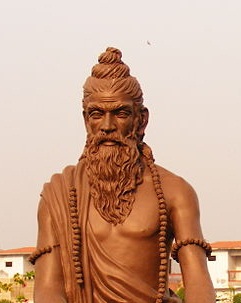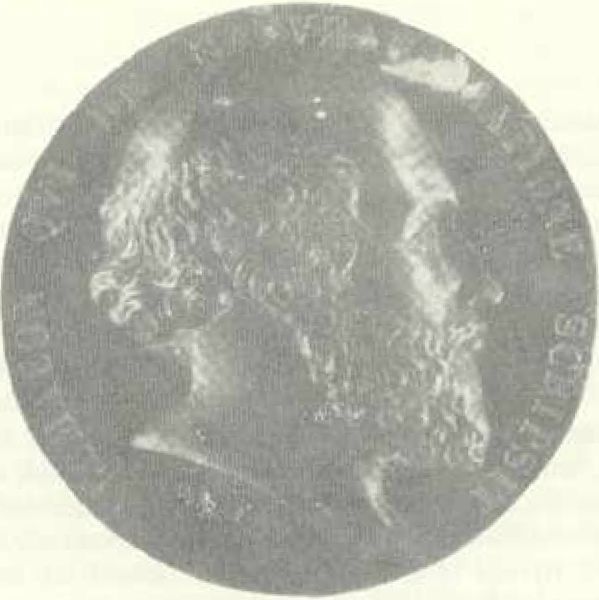<Back to Index>
- Surgeon Sushruta, 800 B.C.
- Philosopher and Medical Theorist Alcmaeon of Croton (Αλκμαίων), 5th Century B.C.
PAGE SPONSOR

Suśruta (Sanskrit: सुश्रुत (sʊʃɾʊt̪), fl. 800 BCE) was an ancient Indian surgeon and is the author of the book Suśruta Saṃhitā, in which he describes over 300 surgical procedures, 120 surgical instruments and classifies human surgery in eight categories. He lived, taught and practiced his art on the banks of the Ganges in the area that corresponds to the present day city of Varanasi in North India.
Because of his seminal and numerous contributions to the science and art of surgery he is also known by the title "Father of Surgery." Much of what is known about this inventive surgeon is contained in a series of volumes he authored, which are collectively known as the Sushruta Samhita.
Sushruta was educated in Varanasi.
There are numerous contributions made by Sushruta to
the field of surgery. Surgical demonstration of techniques
of making incisions, probing, extraction of foreign
bodies, alkali and thermal cauterization, tooth
extraction, excisions, trocars for draining abscess
draining hydrocele and ascitic fluid. Described removal of
the prostate gland, urethral stricture dilatation,
vesiculolithotomy, hernia surgery, caesarian section,
management of haemorrhoids, fistulae, laparotomy and
management of intestinal obstruction, perforated
intestines, accidental perforation of the abdomen with
protrusion of omentum. Classified details of the six types
of dislocations, twelve varieties of fractures and
classification of the bones and their reaction to the
injuries. Principles of fracture management, viz.,
traction, manipulation, appositions and stabilization
including some measures of rehabilitation and fitting of
prosthetics. Classification of eye diseases (76) with
signs, symptoms, prognosis, medical / surgical
interventions and cataract surgery. Description of method
of stitching the intestines by using ant - heads as
stitching material. First to deal with embryology and
sequential development of the structures of the fetus.
Dissection and study of anatomy of human body.
Introduction of wine to dull the pain of surgical
incisions. Enumeration of 1120 illnesses and recommended
diagnosis by inspection, palpation and auscultation.
The earliest surviving excavated written material which contains the works of Sushruta is the Bower Manuscript dated to the 4th century AD, almost a millennium after the original work.
The medical works of both Sushruta and Charaka were translated into Arabic language during the Abbasid Caliphate (750 AD). These Arabic works made their way into Europe via intermediaries. In Italy the Branca family of Sicily and Gasparo Tagliacozzi (Bologna) became familiar with the techniques of Sushruta.
British physicians traveled to India to see rhinoplasty
being performed by native methods.
Reports on Indian rhinoplasty were published in the Gentleman's Magazine by
1794. Joseph Constantine Carpue spent 20 years in India
studying local plastic surgery methods. Carpue was able to
perform the first major rhinoplasty in the western world
by 1815. Instruments described in the Sushruta Samhita
were further modified in the Western World. Even today the paramedian forehead flap
is referred to as the Indian flap.

Alcmaeon (Gr. Ἀλκμαίων, Alkmaiōn, gen.: Ἀλκμαίωνος; 5th century BC) of Croton (in Magna Gręcia) was one of the most eminent natural philosophers and medical theorists of antiquity. His father's name was Peirithus (Peirithos). He is said by some to have been a pupil of Pythagoras, and he may have been born around 510 BC. Although he wrote mostly on medical topics there is some suggestion that he was not a physician but a philosopher of science; he also indulged in astrology and meteorology. Nothing more is known of the events of his life.
He was considered by many an early pioneer and advocate of anatomical dissection and was said to be the first to identify Eustachian tubes. His celebrated discoveries in the field of dissection were noted in antiquity, but whether his knowledge in this branch of science was derived from the dissection of animals or of human bodies is still a disputed question. Calcidius, on whose authority the fact rests, merely says "qui primus exsectionem aggredi est ausus," and the word exsectio would apply equally well in either case; some modern scholars doubt Calcidius' word entirely.
He also was the first to dwell on the internal causes of illnesses. It was he who first suggested that health was a state of equilibrium between opposing humors and that illnesses were because of problems in environment, nutrition and lifestyle. He is said also to have been the first person who wrote on natural philosophy (φυσικὸν λόγον), and to have invented fables. He also wrote several other medical and philosophical works, of which nothing but the titles and a few fragments have been preserved by Stobaeus, Plutarch and Galen. His Concerning Nature might be the earliest example of Greek medical literature.
Alcmaeon of Croton experimented with live animals by cutting the nerve behind the eye to study vision. He also contributed to the study of medicine by establishing the connection between the brain and the sense organs, and outlined the paths of the optic nerves as well as stating that the brain is the organ of the mind. However, his theories were not without mistakes. He said that sleep occurs when blood vessels in the brain are filled and that waking is caused by the emptying of these vessels. He also stated that the eye contains both fire and water.
Although Alcmaeon is often called a pupil of Pythagoras, there is great reason to doubt whether he was a Pythagorean at all; his name seems to have crept into lists of Pythagoreans given us by later writers. Aristotle mentions him as nearly contemporary with Pythagoras, but distinguishes between the stoicheia (στοιχεῖα) of opposites, under which the Pythagoreans included all things; and the double principle of Alcmaeon, according to Aristotle, less extended, although he does not explain the precise difference. Other doctrines of Alcmaeon have been preserved to us. He said that the human soul was immortal and partook of the divine nature, because like the heavenly bodies it contained in itself a principle of motion. The eclipse of the moon, which was also eternal, he supposed to arise from its shape, which he said was like a boat. All his doctrines which have come down to us relate to physics or medicine; and seem to have arisen partly out of the speculations of the Ionian School, with which rather than the Pythagorean, Aristotle appears to connect Alcmaeon, partly from the traditional lore of the earliest medical science.